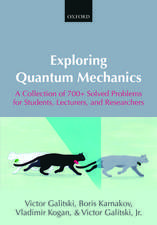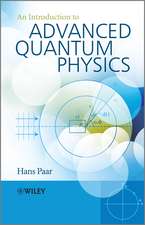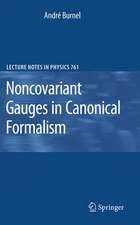Classical Dynamics and Its Quantum Analogues
Autor David Parken Limba Engleză Paperback – 22 noi 2011
Preț: 729.06 lei
Preț vechi: 889.09 lei
-18% Nou
Puncte Express: 1094
Preț estimativ în valută:
139.50€ • 145.65$ • 115.46£
139.50€ • 145.65$ • 115.46£
Carte tipărită la comandă
Livrare economică 05-19 aprilie
Preluare comenzi: 021 569.72.76
Specificații
ISBN-13: 9783642749247
ISBN-10: 3642749240
Pagini: 348
Ilustrații: IX, 333 p.
Dimensiuni: 155 x 235 x 18 mm
Greutate: 0.49 kg
Ediția:2nd ed. 1990. Softcover reprint of the original 2nd ed. 1990
Editura: Springer Berlin, Heidelberg
Colecția Springer
Locul publicării:Berlin, Heidelberg, Germany
ISBN-10: 3642749240
Pagini: 348
Ilustrații: IX, 333 p.
Dimensiuni: 155 x 235 x 18 mm
Greutate: 0.49 kg
Ediția:2nd ed. 1990. Softcover reprint of the original 2nd ed. 1990
Editura: Springer Berlin, Heidelberg
Colecția Springer
Locul publicării:Berlin, Heidelberg, Germany
Public țintă
Professional/practitionerCuprins
1. Rays of Light.- 1.1 Waves, Rays, and Orbits.- 1.2 Phase Velocity and Group Velocity.- 1.3 Dynamics of a Wave Packet.- 1.4 Fermat’s Principle of Least Time.- 1.5 Interlude on the Calculus of Variations.- 1.6 Optics in a Gravitational Field.- 2. Orbits of Particles.- 2.1 Ehrenfest’s Theorems.- 2.2 Oscillators and Pendulums.- 2.3 Interlude on Elliptic Functions.- 2.4 Driven Oscillators.- 2.5 A Driven Anharmonic Oscillator.- 2.6 Quantized Oscillators.- 2.7 Coherent States.- 3. Lagrangian Dynamics.- 3.1 Lagrange’s Equations.- 3.2 The Double Pendulum.- 3.3 Planets and Atoms.- 3.4 Orbital Oscillations and Stability.- 3.5 Orbital Motion: Vectorial Integrals and Hyperbolic Orbits.- 3.6 Other Forces.- 3.7 Bohr Orbits and Quantum Mechanics: Degeneracy.- 3.8 The Principle of Maupertuis and Its Practical Utility.- 4. N-Particle Systems.- 4.1 Center-of-Mass Theorems.- 4.2 Two-Particle Systems.- 4.3 Vibrating Systems.- 4.4 Coupled Oscillators.- 4.5 The Virial Theorem.- 4.6 Hydrodynamics.- 5. Hamiltonian Dynamics.- 5.1 The Canonical Equations.- 5.2 Magnetic Forces.- 5.3 Canonical Transformations.- 5.4 Infinitesimal Transformations.- 5.5 Generating Finite Transformations from Infinitesimal Ones.- 5.6 Deduction of New Integrals.- 5.7 Commutators and Poisson Brackets.- 5.8 Gauge Invariance.- 6. The Hamilton-Jacobi Theory.- 6.1 The Hamilton-Jacobi Equation.- 6.2 Step-by-Step Integration of the Hamilton-Jacobi Equation.- 6.3 Interlude on Planetary Motion in General Relativity.- 6.4 Jacobi’s Generalization.- 6.5 Orbits and Integrals.- 6.6 “Chaos”.- 6.7 Coordinate Systems.- 6.8 Curvilinear Coordinates.- 6.9 Interlude on Classical Optics.- 7. Action and Phase.- 7.1 The Old Quantum Theory.- 7.2 Hydrogen Atom in the Old Quantum Theory.- 7.3 The Adiabatic Theorem.- 7.4 Connectionswith Quantum Mechanics.- 7.5 Heisenberg’s Quantum Mechanics.- 7.6 Matter Waves.- 7.7 Schrödinger’s “Derivation”.- 7.8 Construction of a Wave Function.- 7.9 Phase Shifts in Dynamics.- 8. Theory of Perturbations.- 8.1 Secular and Periodic Perturbations.- 8.2 Perturbations in Quantum Mechanics.- 8.3 Adiabatic Perturbations.- 8.4 Degenerate States.- 8.5 Quantum Perturbation Theory for Positive-Energy States.- 8.6 Action and Angle Variables.- 8.7 Canonical Perturbation Theory.- 8.8 Newtonian Precession.- 9. The Motion of a Rigid Body.- 9.1 Angular Velocity and Momentum.- 9.2 The Inertia Tensor.- 9.3 Dynamics in a Rotating Coordinate System.- 9.4 Euler’s Equations.- 9.5 The Precession of the Equinoxes.- 9.6 Quantum Mechanics of a Rigid Body.- 9.7 Spinors.- 9.8 Particles with Spin.- 10. Continuous Systems.- 10.1 Stretched Strings.- 10.2 Four Modes of Description.- 10.3 Example: A Plucked String.- 10.4 Practical Use of Variation Principles.- 10.5 More Than One Dimension.- 10.6 Waves in Space.- 10.7 The Matter Field.- 10.8 Quantized Fields.- 10.9 The Mössbauer Effect.- 10.10 Classical and Quantum Descriptions of Nature.- References.- Notation.



















